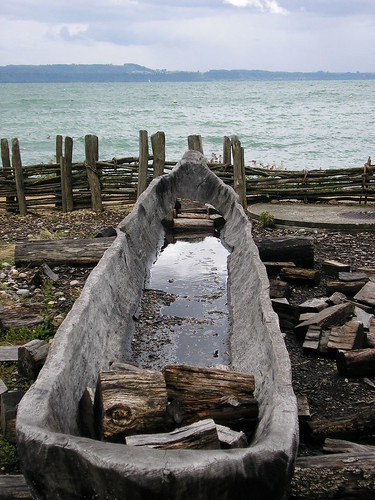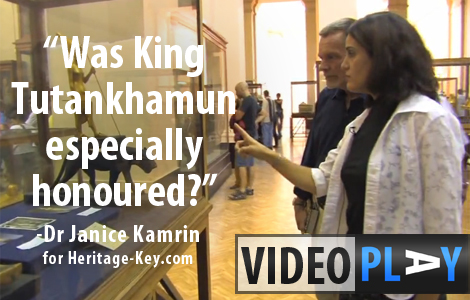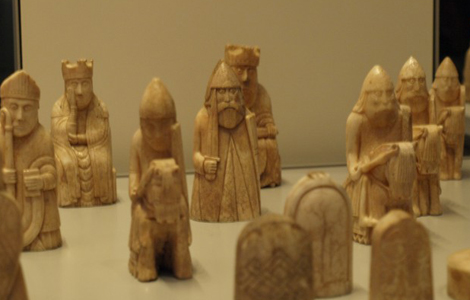South West Maritime Archaeological Group (SWMAG) have sent us some of the first pictures of the remarkable finds recovered from the site of Britains oldest shipwreck a 3,000 year old Bronze Age trading vessel that sunk off the coast of Devonshire in southwest England around 900 BC. We blogged about its discovery on Tuesday. The wreck was located in just a few metres of water at the bottom of Wash Gully near Salcombe. When it went down, the boat was on its way back from the continent with a precious cargo of tin and copper ingots key raw metals in…
-
-
A 3,000 year old Bronze Age trading vessel the oldest shipwreck ever found in British waters has been located off the coast of Devon in southwest England. It went down around 900 BC carrying a precious cargo of tin and copper ingots from the continent, and has lain undetected on the seabed in just eight to ten metres of water in a bay near Salcombe ever since. Experts have hailed the discovery one of only four Bronze Age vessels found in British waters as extremely important, and genuinely exciting. Investigation and recovery work on the boats cargo was carried out…
-
Stonehenge no stranger to mystery was shrouded in a cloak of foggy secrecy on Tuesday night, as the BBC filmed scenes for a forthcoming episode of Doctor Who inside a closed set at the iconic Wiltshire monument. Rumour has it that the first few instalments of the new season of the long-running cult timr-travelling sci-fi drama expected to air sometime in the next few months will be set sometime in the past. Dr Who anoraks observing from the edges of the set, hoping to catch a rare glimpse of filming, spotted the Time Lord himself played by Matt Smith, the…
-
Dr Simon Corcoran and Dr Benet Salway of the history department at University College London have found fragments of an important Roman law code that previously had been thought lost forever. Its believed to be the only original evidence yet discovered of the Gregorian Codex a collection of constitutions upon which a substantial part of most modern European civil law systems are built. They made their remarkable find by painstakingly linking 17 pieces of seemingly incomprehensible parchment. Together they form, according to Dr Salway, a page or pages from a late antique codex book rather than a scroll or a…
-
Nothing keeps Dr Zahi Hawass awake at night quite like the prospect of being the first person to lay eyes on a millennia-dead Egyptian mummy. I could not sleep with thinking about it all the time, he reveals at the start of Heritage Keys latest fantastic video by Nico Piazza, documenting the opening of an intact tomb at Saqqara. Thinking about the moment that I will come down, he continues, about 11 metres, and begin to open a sealed sarcophagus that no one ever touched since 2,600 years ago. The camera pans across creepy piles of heavily decayed human bones…
-
Most of you wont have relished venturing out from under the duvet at all on this snowy Tuesday morning, let alone doing it before the break of dawn. But around 600 intrepid souls were up before the birds today, and wrapped in the their woollens in time to trudge out into the middle of a frozen Wiltshire field for the rising of the sun shortly after 8am, and the celebration of the winter solstice at Stonehenge. Attendance at the event a chilled-out, smaller-scale alternative to the much headier summer solstice is usually a lot higher (2000 people turned out in…
-
The first two instalments of Nico Piazza and Sandro Vanninis four-part video series Tuts Treasures saw Dr Janice Kamrin introduce us to the boy kings canopic vessels (Watch the video) and the various fearsome representations of animal gods that guarded his embalmed body (Watch the video). Part three focuses on the many ritual figures found inside black resined wooden shrines in the treasury of Tutankhamuns lavish tomb in the Valley of the Kings. 34 ritual figures were located in total inside KV62, which was first opened and investigated by Howard Carter in 1922. Their function? Protection basically, and ritual use…
-
In the age of video games, board games might not be the popular pastime they once were. But they have a venerable history. Board games originate thousands of years ago as a spare-time preoccupation of the upper-castes of civilizations from South America to China, Egypt and northern Europe. Each ancient civilization had their own board game of choice. In the Egyptians case it was senet, a complex contest of chance that dating from as long ago as 3500 BC represents the oldest board game in history. The most famous senet board yet discovered comes from the tomb of the legendary…
-
No Christmas would be the same without many a wasted hour spent buried in the couch wiped-out on a bellyful of turkey and stuffing, or nursing a hangover after a Herculean nights mulled wine consumption flicking the channels in a dozy haze. It’s a Christmas tradition (although we can’t guarentee that it dates back as far as some other ancient seasonal rituals) This year you can spare yourself all those awful festive films and Christmas music videos youve seen a million times, by keeping Heritage Keys handy guide to ancient world-themed Christmas TV close at hand. All the old-school three-hours…
-
When the tomb was found it was completely by accident, explains Dr Zahi Hawass, of Howard Carters discovery of KV62, at the start of the final instalment of Heritage Keys four-part video interview series King Tut Revealed, filmed by Nico Piazza and featuring still photography by Sandro Vannini. Having already, in previous videos, disclosed the cause of Tutankhamuns death, shared his thoughts on the curse that apparently befalls all who tamper with the boy kings tomb, and revealed some of the jewellery and other treasures buried with the boy king, Hawass this time talks about tomb robbers in the Valley…






